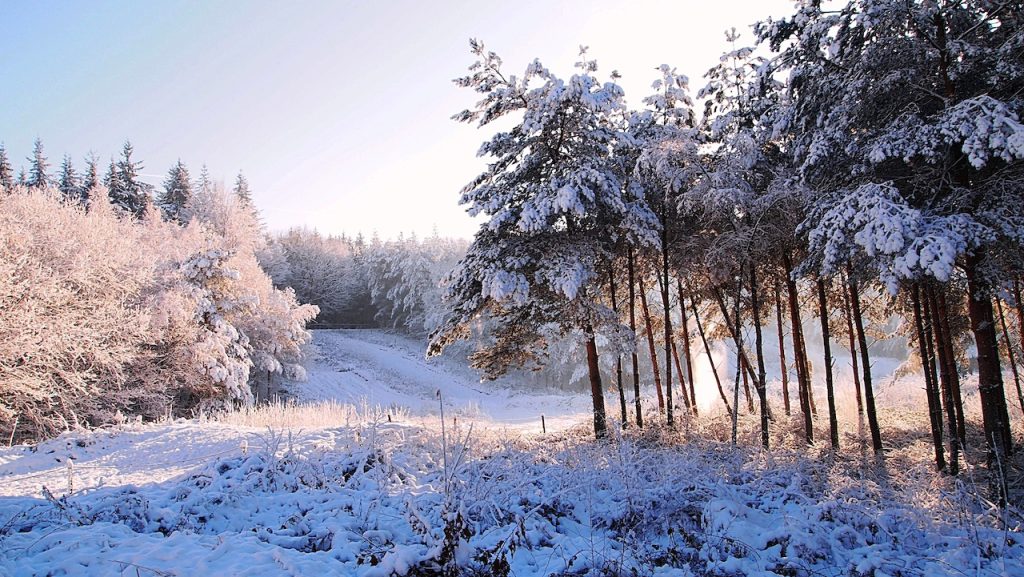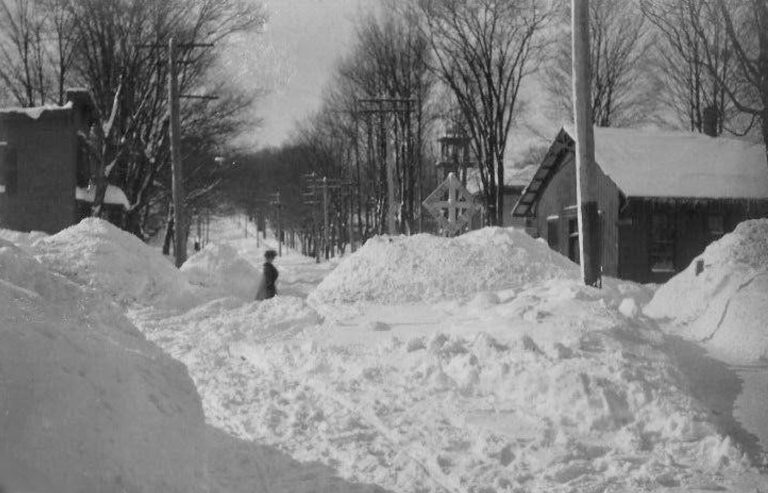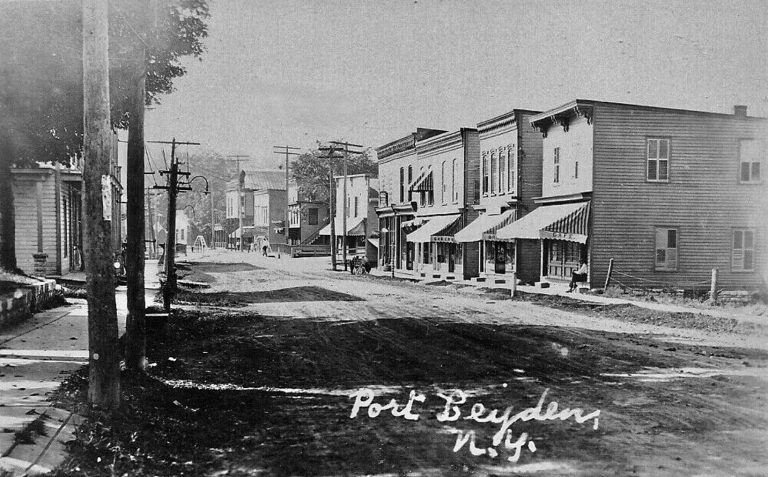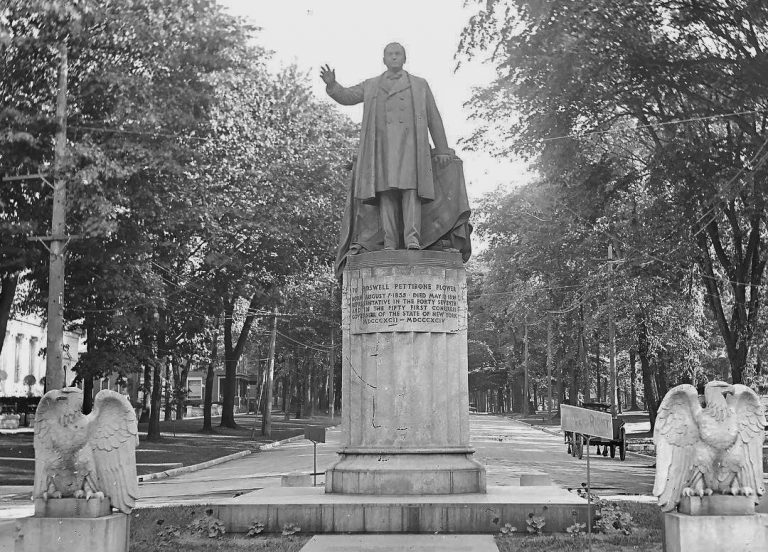A Pioneer Christmas In 1804: Family Relocating To Northern New York Kept Journal Documenting Journey
The following story of a Pioneer Christmas was printed initially on December 24, 1904, in the Watertown Daily Times and is believed to be the earliest account of Christmas in Northern New York of its kind to be preserved. The first part contains an editorial with some background information written in 1904, with the journal entries following.

As photographic cameras were still some 35 years away from their inception, there are obviously no photos associated with the time period. The ones selected for use here are a combination of old postcard photos from around Port Leyden and stock photos. It’s unknown exactly where the journal’s author was heading other than Leyden, New York.
At the time, Leyden was part of a large tract of land, though it is generally believed the destination was near, or in, the town of Leyden, of which Port Leyden is a village. The town of Leyden itself is bordered by the Black River from Lyons Falls, cutting southwesterly and passing less than a mile north of the North Country Manor Bed and Breakfast to about 2.5 miles northeast of West Leyden, continuing northwest for 2.7 miles toward Mohawk Hill before heading northeast back to Lyons Falls, passing less than a mile from Constable Hall.
A map outlining the town of Leyden can be found here.

Introduction from 1904 Article
The way into the north country was a long one during the pioneer days in the history of this section. The trail that the settlers followed led them through a wilderness and forest region unlike anything they had seen before, from the Mohawk country, the Hudson region and the state of Massachusetts, Connecticut and Vermont, from which they came, were all civilized districts compared with the northern New York regions whither they were journeying.
The greater portion of the maps with which these pioneer emigrants had been familiar indicated the entire section as “Irocoisia,” or the land of the Iroquois. Another termed the northern locality as “Conghsagraga,” or the dismal wilderness, and on another older map it is indicated as being the “deer hunting grounds of the Five Nations.”

The only map of an early date reassuring to the trail-follower and homeseeker was one published around 1790. Across the northern part of New York on this map is printed:
“Through mountains which, from Lake Champlain on one side, and the river St. Lawrence on the other side, show their tops always with white snow; but although this one unfavorable circumstance has hitherto secured it from the jaws of harpy land-jobbers, yet no doubt it is as fertile as the land on the east side of the lake, and will in future furnish a comfortable retreat for many industrious families.”
No map published earlier than 1795 has any trace of Black River, and the first appearance of that river upon the map the year following was not extremely auspicious for it is shown as flowing into the St. Lawrence river at Oswegatchie, the present site of Ogdensburg, in Morse’s Geography of 1896.
But the pioneers pressed on into the new country, and dispelled all hesitancy as to just the conditions. A vanguard had advanced and brought back the information that the country was good. This was all that was necessary. The men, a few years out of the revolution, hitched the oxen onto the crude, old cart, piled in the lares and penates and started with their families for the new homes.
An old writer northern New York history has this to say, “Of all peoples going into a new country to establish homes none carried wit them so sacredly and adhered to the traditions, customs and observances of the fathers so tenaciously as the first settlers f this locality.”

In the North country the truth of this statement is evident on every hand. In the spoken language, in certain modes of agricultural work in the cooking of food, and a score of other ways, this is demonstrated 100 years after the first pioneers came.
There has been preserved in a little oblong box, covered with deer skin, a journal the pages of which are now yellowed with age. The book contains the written account of the journey of one of the first pioneers of this section, up through the Black river country and to the new home. The diary, for it is such, also tells the story of this pioneer and his family, in their struggle to establish themselves in the wilderness home. The journey was made aboard a sled drawn by an ox team, and it was undertaken and completed in the month of December, 1804, just 100 years ago.
The pages are written in a plain, neat hand and at this late day the characters stand out like copper plate and are very easily read. The book, under the date of Dec. 26, 1804, contains probably the first written account of a pioneer North Country Christmas that has been preserved.
The author John Gibbs, made the journey with his wife and a son of 7 years and a daughter, aged 5 years, starting from Meriden, Conn. They made the journey to take up lands in the town of Leyden, Lewis County, where friends from the same village in New England had preceded them and would give them welcome even in the winter. The extract which follows is from the diary of the pioneer.

A Pioneer Christmas – Diary Entries
“We have been on the road nigh a month, and the farther we traverse the more difficult becomes the way. The road all the way from Meriden to Whitesboro was unusually good and the sled ran well. The oxen had good feed on the lower roads but since we turned north at Whitesboro into this wilderness things have been different. The way has been very difficult and the oxen have fared poorly.
“I have attempted to keep to the road up through this country, but snow to the depth of two feet fell day before yesterday and there has been no great joy in traveling. I had thought that with this fall of snow it would be more easy to get over the road through the tangled underbrush and around fallen logs. But I find this condition much worse than before. For the past two days my wife has driven the team and I have gone on before with the ax in hand to clear the way.
“Both children are happy, for they are warm. In the sleigh we have a feather bed which my wife was anxious to take to the new home and in this we keep the children stored so that they do not get cold. Roxy (the wife) and I are not disheartened, for we know the way is not a deal longer.
“Yesterday was Christmas and Sunday, too. Saturday it began snowing about noon and continued during the night, and early Christmas morning a fall of two feet was upon the ground in addition to that already on the ground. Saturday morning shortly before the hour of 11 I believe I could tell by the feel of the air that a storm was coming.

“We stopped before noon, knowing that we could get nowhere in the storm. Our halting place was in a long tract of woods. I made a temporary shelter to protect us from the storm by putting up two crotchets. Across these I extended poles and covered them with hemlock boughs. We placed what part of the sled’s load we cared to protect under this shelter, and I soon had a rousing fire built in front of the camp.
“The children seemed to enjoy the novelty of this outdoor house and had high fun playing about. The oxen I let loose to browse, and I cut a quantity of limbs which they considered a rare treat. They appeared to enjoy it thoroughly as though it had been the best grade of Connecticut hay.
“My wife and I realized that it was Christmas eve, and the children had anticipated its coming for many days. The night was dark in the extreme and I feared for the oxen, but arranged a pen for them in which they remained in safety during the night.
“When the children were ready to go to bed they talked incessantly of the morrow and what it would bring. Roxy and I had prepared for just such an emergency. Before we left Meriden we bought several pieces of the candy in sticks and lump form. Roxy also made some doughnut men, and women, fashioning them in the image of beings. Too, the children’s aunt made a rag doll for the girl and a jack-on-the-stick for the boy. These we placed in a box aside from the rest of our goods and they made the journey with us.

“When the children went to bed they hung up their stockings on the sticks that came down from the roof of the shanty. They were confident that Santa Claus would find them and their confidence was rewarded yesterday morning when they woke and found the gift tucked into the little stockings. Their joy at the gifts was beyond their power of expression.
“We remained in the camp the entire day yesterday. I did not deem the weather auspicious for the continuance of the journey and did not care to travel upon that day, anyway, it being Sunday.
“Our provisions have been becoming lower and lower until the last few days we have near reached the bottom of supplies. I went out yesterday forenoon and experienced little difficulty in shooting four partridges which flew up within a few rods of camp. We had the tiniest kind of a Christmas dinner off from them. We had no salt left and so I used pork instead. I cut the pork in small bits and inserted it into the flesh of the fowls. It then served the double purpose of salt and butter for basting as well. The dish was a rare one and we all enjoyed it, considering it a Christmas feast in every sense.

“I said that the Children enjoyed the Christmas gifts very much. When they rose yesterday morning and saw presents they danced about the fire and sang, saying that they were glad they weren’t back east. After breakfast they sympathized with the oxen because they had no Christmas.
“Last night our stay in the camp was not as enjoyable as that of the previous night. About 4 yesterday afternoon the wind veered around into another quarter and had a tendency to blow the snow through the opening of the bough house.
“We rose this morning at daylight and resumed our journey north. I have had a great trouble all day following a trail, but believe we are now tending directly toward Leyden. The plan we still follow in conducting our journey is that I go along ahead, find the ax blazes upon the trees, and Roxy drives the oxen forward. We passed a little cluster of houses this noon and the settlers asked us to remain a time with them and rest our animals and ourselves.
I did not consider it best to do so. The oxen had a good rest over the Sabbath, and then the weather is quite good now and fairly warm for the season of the year. We cannot tell what kind of weather a few days will bring forth. The people where we stopped are named Maltiner and they come from Fairfield, Herkimer county.

They told us that the Topping Settlement at Leyden is about three days’ journey yet. This is encouraging and we will renew the traveling tomorrow morning with strong hearts. Two wolves skulked into the open beyond the camp last night and howled for several minutes. I threw some fire in their direction and they ran off into the deeper woods. They gave the oxen no trouble during the night. Both of the Children are extremely well and Roxy is standing the trip first rate, apparently growing strong in the outdoors.
The portion of the narrative which concerns the journey with the oxen closes at this point, but subsequent entries display the fact that family arrived at the home of William Tipping in the town of Leyden, Lewis County, “a little northeast of Sugar river,” on Dec. 28, safe and in good condition.
They spent the remainder of the winter with the Topping family and with the first appearance of spring John Gibbs constructed a log house of his own out of the timber which he had cut during the winter. The clearing of tract of land was also begun and with the strenuous beginning the family founded a home in the new country.
The extract from the diary of John Gibbs tells of but one pioneer Christmas, yet could the annals of North Country history be written in all detail of fact and human interest they would narrate scores of similar experiences varying only in general setting and arrangement.

Every wilderness conqueror who set out with his family into the new country carried with him the Christmas tradition and the manner of its observance, just as surely as he carried the methods of spring sowing and of the harvest. In every log house in Jefferson, Lewis, St. Lawrence, and Franklin counties, with the coming of Christmas eve its observance followed as sacredly as though there were no besetting obstacles.
















1 Reviews on “Northern New York Pioneer Christmas – 1804”
How do I find the complete diary?
I’m not sure. I would normally suggest contacting the Watertown Daily Times, but the article was written in 1904.